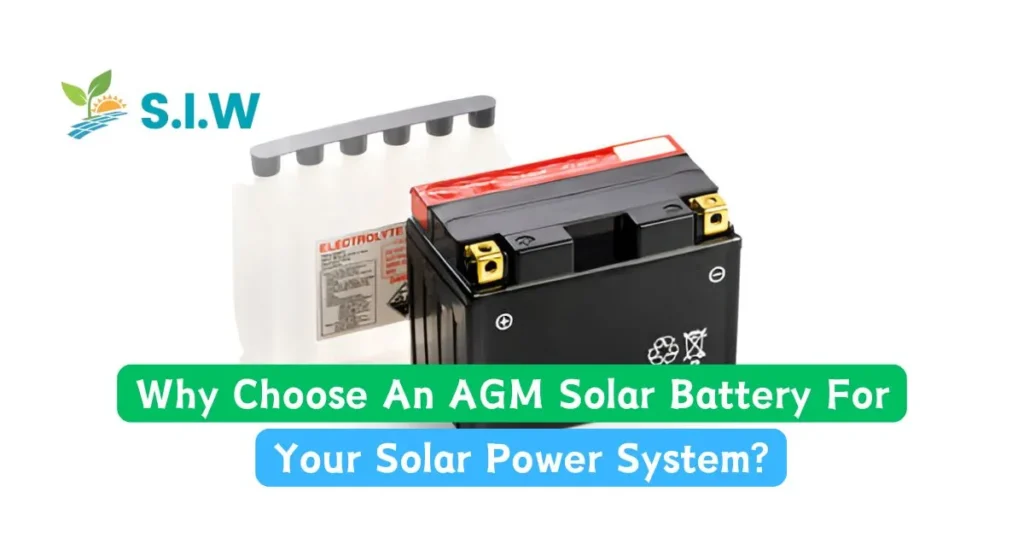AGM (Absorbent Glass Mat) solar batteries are a type of lead-acid battery commonly used in solar power systems due to their durability, maintenance-free nature, and efficient energy storage capabilities. These batteries have gained popularity in off-grid and backup power applications, thanks to their reliable performance and long lifespan. Below is an in-depth guide to understanding AGM solar batteries, their benefits, and their application in solar energy systems.
1. What is an AGM Solar Battery?
AGM solar batteries are a specific type of sealed lead-acid battery that uses absorbent glass mat technology. Unlike traditional lead-acid batteries, AGM batteries have fiberglass mats that absorb and contain the battery’s electrolyte, making them spill-proof and safer to handle. This design also allows for lower internal resistance, which results in faster charging and higher current delivery.
2. How AGM Solar Batteries Work
AGM batteries operate by using lead plates and an electrolyte solution composed of sulfuric acid and water. The absorbent glass mats between the plates hold the electrolyte in place, which prevents the liquid from sloshing around and leaking. This structure allows AGM batteries to deliver a stable and consistent flow of power, which is crucial for solar energy systems that require dependable energy storage.
3. Benefits of AGM Solar Batteries
- Maintenance-Free: AGM batteries are sealed, which means they don’t require regular maintenance, such as adding water. This makes them convenient for solar systems, especially in remote or hard-to-reach locations.
- Long Lifespan: AGM batteries typically have a longer lifespan compared to traditional lead-acid batteries, with many models lasting 5 to 7 years or more with proper care.
- Deep Discharge Capability: AGM batteries can be discharged to a greater extent without damaging the battery, making them ideal for solar applications where deep cycling is common.
- Efficient Charging: These batteries charge faster than conventional lead-acid batteries due to their low internal resistance, making them more efficient in solar power systems where quick energy replenishment is necessary.
- Safe and Environmentally Friendly: AGM batteries are spill-proof and can be installed in various positions without risk of leakage. They are also more environmentally friendly, as they reduce the risk of acid spills.
4. Applications of AGM Solar Batteries
AGM solar batteries are used in a variety of solar energy applications, including:
- Off-Grid Solar Systems: AGM batteries are commonly used in off-grid solar setups where a reliable energy storage solution is needed to power homes or cabins during periods without sunlight.
- Backup Power Systems: For grid-tied systems, AGM batteries can provide backup power during outages, ensuring a continuous power supply.
- Recreational Vehicles (RVs) and Boats: Due to their maintenance-free nature and ability to withstand vibration, AGM batteries are popular in RVs and boats that use solar power.
- Telecommunications and Emergency Systems: AGM batteries are often employed in critical systems that require dependable power storage.
5. Comparing AGM Solar Batteries to Other Types
- AGM vs. Flooded Lead-Acid Batteries: Flooded lead-acid batteries require regular maintenance (e.g., adding water) and are prone to leaking. AGM batteries, on the other hand, are sealed and maintenance-free, offering greater convenience and safety.
- AGM vs. Gel Batteries: Gel batteries also use sealed technology, but the electrolyte is in gel form. AGM batteries typically have lower internal resistance, allowing for faster charging and better performance in high-current applications.
- AGM vs. Lithium-Ion Batteries: Lithium-ion batteries are known for their high energy density and long lifespan, but they are significantly more expensive than AGM batteries. AGM batteries are more affordable and can be a better option for those on a budget.
6. Factors to Consider When Choosing an AGM Solar Battery
- Capacity: The battery’s capacity, measured in ampere-hours (Ah), determines how much energy it can store. Ensure that the battery’s capacity matches your energy needs.
- Voltage: AGM solar batteries are available in various voltages, typically 12V, 24V, or 48V. Choose a voltage that is compatible with your solar power system.
- Cycle Life: This refers to the number of charge and discharge cycles a battery can undergo before its performance degrades. A higher cycle life means a longer-lasting battery.
- Temperature Range: AGM batteries perform well in a wide range of temperatures, but extreme conditions can affect their lifespan. If you live in an area with harsh weather, consider a battery with a suitable temperature range.
7. Maintenance and Care for AGM Solar Batteries
While AGM batteries are maintenance-free, there are still some practices to ensure optimal performance:
- Proper Charging: Avoid overcharging or undercharging the battery, as this can shorten its lifespan. Use a charge controller to regulate the charging process.
- Temperature Monitoring: Keep the battery in a location with moderate temperatures to prevent damage from extreme heat or cold.
- Regular Inspection: Periodically check for any signs of physical damage or corrosion on the battery terminals.
8. Is an AGM Solar Battery Right for You?
AGM solar batteries offer a reliable, maintenance-free solution for energy storage in solar power systems. They are particularly well-suited for off-grid applications, backup power, and environments where traditional lead-acid batteries may be less practical. If you’re looking for a cost-effective and durable battery for your solar setup, an AGM battery may be the perfect choice.
By considering factors such as capacity, voltage, and cycle life, you can find the right AGM battery to meet your specific energy needs. With proper care and usage, AGM solar batteries can provide years of dependable service, helping you make the most of your solar energy system.








